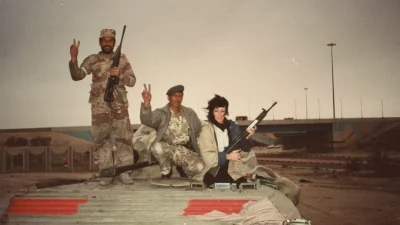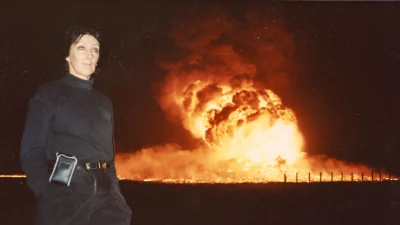
Lucy Lawless will Never Look Away From A Great Story
Art
The formidable figure of a tall, powerful woman with jet-black hair rushes into the battlefield. This is what she was born to do, and she loves every minute of it. This could easily be a description of Xena: Warrior Princess, the fictional action heroine immortalized by New Zealand-born actress Lucy Lawless on television in the 90s. Or it could be Margaret Moth, the very real protagonist of Lawless’ feature directorial debut Never Look Away. The riveting documentary, which chronicles Moth’s colorful life and career made its premiere at the 2024 Sundance Film Festival on January 19 at the Prospector Square Theater.

“I love bad girls, and I think we all wanna live a little more courageously, we all wanna care less what people think of us,” Lawless says, explaining her attraction to the subject matter. Margaret Moth blazed her own trail in the world, never stopping to worry about what anyone thought of her. She began her career as the first woman to work as a news camera operator in New Zealand, working at the local DNTV2 station in South Island, before moving to the United States, settling in Texas. Moth eventually became one the top photojournalists for CNN, capturing powerful footage on the ground in the Persian Gulf War, in India following the assassination on Indira Gandhi. She also covered conflicts in the West Bank, Bosnia, Lebanon and Tbilisi, Georgia. Margaret was driven by a mission to show the world the harsh realities of war and the devastating effects on the lives of civilians caught in the crossfire.
“She’s inspirational. She did so much when so much was taken away from her. So, who are we not to go out and be marvelous, right?”
In 1992, when a sniper’s bullet in Sarajevo shattered her jaw, destroying all of her teeth and much of her tongue, she didn’t just survive, she went back into the very same war zone six months later with a camera on her shoulder and a renewed sense of determination in her heart. While no enemy combatant could bring her down, Moth was sadly lost to cancer on March 21, 2010, but her legacy lives on. “She’s inspirational. She did so much when so much was taken away from her,” Lawless says. “So, who are we not to go out and be marvelous, right?”
When Lawless received a call from Joe Duran, Moth’s closest friend and heir to her estate, asking if Lawless wanted to make the film, she didn’t think twice about it. “She was a very complicated figure,” says Lawless, familiar with Moth’s story, as the trailblazing photojournalist is something of a legend in New Zealand. “We’re all interested in Kiwis who make it abroad, more so than those who make it at home. We’re not very impressed by that,” Lawless says. Lawless put in a call to a friend, actor-turned-producer Matthew Metcalfe (The Circus) to get him onboard the project. Once Maetcalfe said yes, there was no turning back. They were determined to get the film made, and one important part of that was getting their hands on the footage necessary to tell Moth’s story. “It was exhaustive,” Lawless says. It was then that Wenwen Li, a filmmaker and researcher in New Zealand who served as Archival Producer for the film, went to work. “She went through thousands and thousands of hours of footage,” Lawless says. “Not just Margaret’s but everybody’s, and helped whittle it down to the best images. “Wenwen and Tim Woodhouse, my editor, were my guiding angels. They really fixed my broken heart.”
“I love bad girls, and I think we all wanna live a little more courageously, we all wanna care less what people think of us.”

In addition to extensive archival footage, Never Look Away relies heavily on interviews with Margaret Moth’s colleagues at CNN, including Stephano Koutsonis, Christinane Amanpour and Joe Duran. Perhaps one of the most heartbreaking aspects of the film is the extensive interviews with Jeff Russi, Moth’s lover, who met her in Houston when he was only 17. “Jeff Russi became such a good friend to me through this process,” Lawless says. Russi even shared a collection of drawings that Moth had made during their time together, which vividly portray the bleak childhood filled with abuse and neglect that haunted her throughout her life. “He said ‘I need to let these go.’”, Lawless says. “He had never gotten over Margaret.” Tragically, Russi died in December of 2023 and was unable to see the completed film.
“The men and women who risk their lives to tell the stories of the non-combatant victims of war, those people are heroes.”
The stirring images of a war-torn world, and the vivid portrait of a woman obsessed with sharing the truth with the world make Never Look Away a harrowing monument to resilience. If there’s one thing that Lawless hopes audiences will take away from her film above all else, it’s a sense of love and respect for journalists working in war zones. “The men and women who risk their lives to tell the stories of the non-combatant victims of war, those people are heroes,” Lawless says. “And they deserve our respect and protection.” It’s simply impossible to watch Never Look Away and not gain a profound respect and love for Margaret Moth, an exemplary spirit who left an inedible mark on the world forever.
Read more of SLUG’s comprehensive coverage of the 2024 Sundance Film Festival.